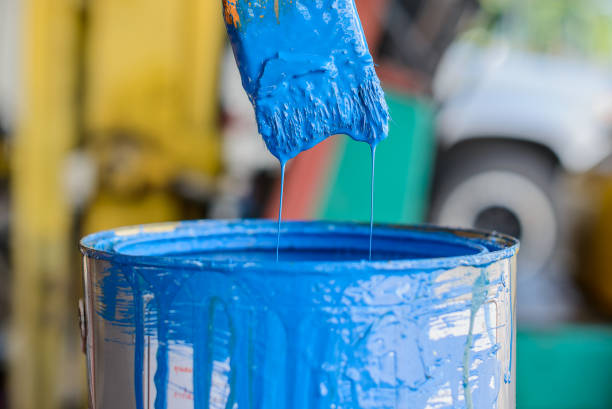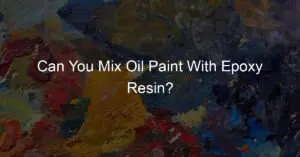Oil paint has been a popular medium for artists for centuries, known for its versatile application and vibrant colors. With the growing awareness of environmental conservation and individual health, it raises the question of whether oil paint poses any toxicity risks to artists and their surroundings.
To assess the potential hazards of oil paint, it is essential to examine its composition. Oil paint typically consists of pigments suspended in a drying oil, often linseed oil. While most of the pigments used in modern oil paints are considered relatively safe, certain historical pigments such as lead, cadmium, and mercury have been identified as toxic and are now used sparingly or replaced with less harmful alternatives.
Understanding the risks associated with using oil paint can help artists make informed decisions about the materials they choose and the precautions they should take. To ensure a safe and healthy artistic practice, it is crucial to be aware of potential toxicity in oil paint and adapt workspace habits accordingly.
Composition of Oil Paints
Oil paints consist of two primary components: pigments and a drying oil. Pigments are finely ground particles that provide the color and opacity to the paint. They come from various sources, such as minerals, plants, and synthetic compounds. The drying oil acts as a binder that holds the pigments together and helps them adhere to the painting surface properly.
There are several types of drying oils commonly used in oil paints. Some popular examples include linseed, safflower, walnut, poppy, and alkyd. Each oil has distinct properties that affect the paint’s drying time, consistency, and overall finish. These differences are an essential aspect of the characteristics and behavior of oil paints that artists utilize.

- Linseed oil: This is the most widely used oil in oil paint formulations. It provides a strong, flexible, and durable film. The dry time of linseed oil is moderate compared to other oils. It tends to yellow slightly over time.
- Safflower oil: This oil has a slower dry time and less yellowing than linseed oil. It is commonly used as a binder for whites and pale colors to maintain their brightness over time. However, safflower oil produces a less robust paint film.
- Walnut oil: Known for its non-yellowing property, walnut oil dries slowly and forms a less strong paint film than linseed oil. It is favored for preserving colors’ vibrancy in paintings.
- Poppy oil: With a slow drying time and minimal yellowing, poppy oil is often used in lighter colors. The trade-off is a less stable paint film; it tends to become brittle over time, making it less suitable for thicker applications.
- Alkyd: An alkyd is a synthetic resin that is modified and reacts with drying oils like linseed oil. The resulting paint dries faster, has increased gloss, and forms a more stable paint film than traditional oil paints.
In addition to pigments and drying oils, some oil paints also contain heavy metals. These metals can have toxic properties and pose potential health hazards. Common heavy metals found in oil paints include lead, cadmium, and chromium. These elements are used for their color properties, such as creating vibrant reds, yellows, and greens. Environmental and safety regulations have led to the development of alternative pigments that are non-toxic and safer for artists and the environment.
In conclusion, the composition of oil paints is a complex balance between pigments and drying oils, with variations in oil types, pigments, and additives contributing to the unique properties of each paint. An understanding of these components is essential for artists to achieve the desired effects in their work.
Toxic Elements in Oil Paints
Common Toxic Pigments
Oil paints are known for their rich color and consistency, but certain pigments can contain toxic elements that could pose health risks. Some commonly used pigments are lead, cobalt, and cadmium. Lead, for example, can be found in lead white oil paint and is known to be hazardous if ingested or inhaled. Similarly, cobalt and cadmium are commonly used to create blue and yellow pigments, respectively, and can also be harmful if not handled properly.
It is essential for artists working with oil paints to familiarize themselves with the ingredients and potential hazards of the materials they are using. Conducting thorough research and purchasing from trusted brands can help reduce potential risks.
Solvents and Mediums
In addition to pigments, the solvents and mediums used in oil painting can also contain toxic substances. Turpentine and white spirits are commonly used solvents that can emit harmful vapors. Prolonged exposure or ingestion may cause serious health issues.
Artists can opt for alternatives, such as water-mixable oils, to reduce the need for solvent use. This type of paint can be thinned and cleaned with water instead of harmful solvents. Another option is Gamsol, which is an odorless mineral spirit that has lower toxicity and is less harmful than traditional solvents.
Oil painting mediums and varnishes can also contain toxic substances. Varnish, for instance, often includes solvents like turpentine or white spirits in its formulation. It is crucial for artists to handle these materials with care, wear protective gear, and work in a well-ventilated space.
By understanding the potential hazards present in oil paints, artists can take necessary precautions and make informed decisions about which materials to use to create beautiful and safe works of art.
Health and Safety Concerns
Inhalation and Air Quality
When using oil paints, it is important to be aware of the potential health risks associated with inhalation. Some oil paints contain harmful chemicals and fumes that can cause dizziness, confusion, and even poisoning if inhaled in large amounts or over an extended period. Therefore, it is important to work in a well-ventilated area to ensure proper air circulation. Consider wearing a mask to minimize direct inhalation of fumes. Be mindful of any strong smell, as it may indicate the presence of potentially toxic fumes.
Skin Contact and Allergic Reactions
Skin contact with oil paints can lead to skin irritation or even allergic reactions in some individuals. It is crucial to take precautions to avoid direct contact with the skin. Wearing gloves when handling oil paints can prevent skin irritation and protect against potential toxicity.
If contact with the skin does occur, wash the affected area thoroughly with soap and water. Keep an eye out for any signs of a rash or irritation, as this may indicate an allergic reaction. Remember always to read the labels on the paint products to understand the potential risks associated with their use. By taking these safety precautions, you can minimize your risk and enjoy creating art with confidence and knowledge.
Environmentally Friendly Alternatives
Oil painting can be a rewarding hobby, but concerns about its potential toxicity and impact on the environment are understandable. Thankfully, there are environmentally friendly alternatives available that allow artists to enjoy oil painting without the guilt.
One way to reduce the environmental impact of oil paints is by choosing natural oils as a base, such as linseed oil, walnut oil, safflower oil, or poppy oil. These oils are renewable resources derived from plants, making them a more sustainable option compared to traditional petroleum-based oils. Additionally, they often have minimal odor, making them a more pleasant option for use in confined spaces or by artists with sensitivities to strong odors.
In addition to natural oils, artists can choose water-mixable oil paints. These paints can be thinned and cleaned with water, making them a safer alternative to traditional oil paints that require solvents like mineral spirits or turpentine. By using water in place of solvents, artists help reduce the amount of harmful volatile organic compounds (VOCs) released into the environment.
Furthermore, there are synthetic alternatives for artists who prefer a more sustainable option. For example, some innovative products on the market replace petroleum-based resins with resins made from vegetable oils. These oil-based painting mediums offer the same performance as traditional mediums, with the added benefit of lowering the environmental footprint.
Drying time is an important factor to consider when using environmentally friendly alternatives, as it can affect the longevity and stability of a painting. While some natural oil-based alternatives may take longer to dry compared to their conventional counterparts, others, like safflower oil, dry relatively quickly. If drying time is a concern, artists can explore adding fast-drying mediums to their oil paint mixtures, as long as they are compatible with their chosen paint.
To sum up, environmentally conscious artists have several options to reduce the potential toxicity of their oil painting materials. By opting for natural oil-based paints, water-mixable oil paints, or synthetic alternatives, they can create beautiful works of art while minimizing their impact on the environment.

Safe Practices for Oil Painting
Cleaning Brushes and Materials
To maintain good health while oil painting, it’s crucial to properly clean your brushes and materials. Use a non-toxic brush cleaner or gentle soap, such as ivory soap, to remove paint from brushes. Avoid using harsh solvents, as they can release VOCs (volatile organic compounds) into the air. For cleaning palettes and other surfaces, a mild detergent and warm water should suffice. Remember to properly dispose of hazardous waste like used rags and paint residues in a sealed container.
Proper Ventilation
Working in a well-ventilated space is essential when using oil paints. Many oil paint products emit hydrocarbons and VOCs, which can be harmful if inhaled for prolonged periods. Ensure your painting area has adequate airflow by opening windows or using a fan. If your studio lacks proper ventilation, consider investing in an air purifier that can effectively filter out VOCs and airborne particles.
Personal Protective Equipment
While most oil paints are not overtly hazardous, certain pigments like manganese and cobalt blue can pose risks when handled improperly. Always wear gloves when you paint to avoid skin contact with potentially harmful materials. Additionally, it’s wise to wear a protective mask while working with oil paints containing high levels of VOCs.
By following these safety precautions, you lower your risk of exposure to potentially toxic substances found in some oil paints. Keep these practices in mind to maintain a healthy and enjoyable oil painting experience.
Myths and Misconceptions
There are several myths and misconceptions surrounding oil paints and their toxicity. One common myth is that all oil paints are toxic due to the presence of heavy metals and chemicals. While some oil paints do use toxic substances, many manufacturers have taken steps to replace harmful materials with safer alternatives. Consequently, it is crucial to check the labels on paint tubes for specific information about the materials used.
Another misconception is that the fluidity and smoothness of oil paints are due to toxic chemicals. In reality, these properties are a result of the mixture of pigment and oil, typically linseed oil. Linseed oil is not toxic and has been used as a safe binder in oil paints for centuries. The perception of toxicity may stem from the use of toxic solvents like turpentine that can be used to thin oil paints. However, there are many alternative solvents available on the market today that are less toxic and have low odor.
In terms of resources for reliable information, MedlinePlus is a trustworthy website to access detailed, research-backed descriptions of potential health effects related to specific chemicals found in art materials. Moreover, paint manufacturers have started to provide safety sheets to assist artists in understanding the contents and risks of using their products.
Artists also might be concerned about the potential impact of oil paints on their creativity due to the presence of toxic chemicals. The truth is that with proper care and adherence to safety guidelines, using oil paints does not pose a significant risk to one’s health or creativity. It is essential to use proper ventilation, wear protective gear like gloves, and dispose of wastes responsibly to minimize risks while painting.
In conclusion, while some oil paints may contain toxic chemicals, it is essential to be aware of the specific components in the paints and solvents you use. Educate yourself on best practices, safety measures, and the available alternatives to ensure a safe and enjoyable experience with oil painting.
Special Considerations
When using oil paints, it’s essential for oil painters to be aware of the potential hazards and take necessary precautions to protect themselves, their families, and their environment.
Firstly, oil paints may contain toxic pigments that can cause harm if ingested, inhaled, or absorbed through the skin. It’s crucial to keep paint materials away from children, pregnant individuals, and pets to avoid accidental consumption. Moreover, avoid eating or drinking while handling paints to minimize the risk of ingestion.
Using water mixable oil paints can be an excellent alternative for those worried about toxicity since they can be cleaned up with water and do not require toxic solvents for cleanup. High-quality paint products can also reduce the risk, as reputable manufacturers usually adhere to safety standards and strive to create a safe painting experience.
Inhalation of fumes can be another concern, especially if you’re working with solvents or varnishes that contain hazardous chemicals, such as formaldehyde. Ensure proper ventilation in your workspace to prevent inhaling potentially harmful fumes.
When disposing of used paint materials, consider them as hazardous waste. Dispose of them according to your local waste disposal regulations to avoid harming the environment or other people.
Lastly, sanding surfaces covered in oil paint can release toxic particles into the air. Wear a mask and take added precautions to avoid inhalation of these particles. By being aware of the potential dangers and taking proactive steps, you can enjoy oil painting safely and responsibly.

Frequently Asked Questions
Are oil paint fumes harmful to inhale?
Oil paint fumes can be harmful, especially if you inhale them for prolonged periods. Some oil paints contain volatile organic compounds (VOCs) that can cause respiratory irritation, headaches, and dizziness. Always work in well-ventilated areas and consider using low-VOC or natural alternatives when possible.
Can oil painting cause health issues?
While occasional exposure is unlikely to cause problems, long-term exposure to the chemicals in oil paints may pose health risks. These risks largely depend on the specific pigments and solvents used in the paint. Some pigments, such as lead or cadmium, are highly toxic and can cause serious health issues. Always follow proper safety recommendations when handling oil paints and avoid eating, drinking, or smoking in the area where you are painting.
Is it safe to use oil paints indoors?
Using oil paints indoors is generally safe if you follow proper safety guidelines. This includes ensuring adequate ventilation and using protective gear when needed. Be mindful of the specific materials you are using, as some pigments and solvents may require additional precautions.
What are the symptoms of oil paint toxicity?
Symptoms of oil paint toxicity can vary, but common signs include headaches, dizziness, nausea, skin and eye irritation, and difficulty breathing. If you suspect you have been exposed to toxic substances while painting, it is important to seek medical advice promptly.
How do oil paints impact the environment?
Oil paints can have a negative impact on the environment, partly due to the extraction and processing of pigments. Additionally, the use of hazardous chemicals in traditional oil paints can contribute to air and water pollution. Disposing of these materials improperly can also leach toxins into the soil and water supply. Consider using environmentally friendly alternatives and follow local regulations for proper disposal of oil paint waste.
Are there non-toxic alternatives to oil paints?
Yes, there are non-toxic alternatives to traditional oil paints. Options such as water-mixable oil paints, which contain no hazardous solvents, and natural earth pigments, which do not contain harmful substances, can provide a safer experience without compromising artistic quality. Always research and choose products that best suit your needs and preferences while prioritizing safety and environmental impact.
I



















